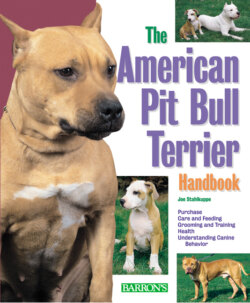Читать книгу American Pit Bull Terrier Handbook - Joe Stahlkuppe - Страница 24
На сайте Литреса книга снята с продажи.
Legal Lightning Rod
ОглавлениеWith the development of a widely accepted public perception of the APBT as the “Bogey-Dog” came the first of a group of legal remedies designed to protect society from the canine equivalent to the great white shark. First came restrictions on all breeds, some of which were reasonable, such as leash laws and dog licensing. The day of the household pet unrestrictedly roaming the community was over, and rightfully so. Again, this was a positive move that effectively brought to an end much of the mischief unattended dogs can get into. It also helped lower the number of dog deaths caused by cars and trucks. Dog bites went down. Altercations between dogs went down. Unwanted litters dropped.
Many people began walking with their dogs, jogging with their dogs, promenading with their dogs on city streets, in city parks, and along suburban avenues. A new type of conflict began to result from this new activity. Some people couldn’t (or wouldn’t) control their pets. Others actually seemed to enjoy strutting through the community with a large, impressive, possibly aggressive, dog. The element of human ineptitude and ego actually produced a worse situation than had existed in some communities before leash laws and other restraints took effect.
In the pre-leash law days, free-ranging dogs in a particular area often came to mutual understandings among themselves about who was the strongest and meanest dog. Most spur-of-the-moment dogfights ended with one dog submitting to another. The loser would find a different fire hydrant and a different place in the pecking order. This peace would last until some new challenger arrived to change the balance of power. These informal rank orderings, structured by the canines themselves, disappeared when dogs were kept behind fences. The human element entered the equation.
In most communities there were usually restrained animals, even before leash laws. Many APBT owners, and owners of similar dogs, kept their animals securely behind fences. The APBT was not, and is not now, a dog to be allowed in the informal community leadership ladder contests. The APBT owner knew that and few problems occurred. Owners of other dogs allowed their dogs to run free, but the wise APBT owner never would take this chance.
When unwise and impulsive people began to see that the “pit bull” could be an effective tool In fostering a tough image, the breed began its downhill slide. Dogs of the “pit” type began to be bred not for their usual companionable traits, but for aggressiveness, first toward the other guy’s dog, then toward the other guy.
“Pit bulls” that would have, in earlier times, been destroyed by their owners as temperamentally unsound, suddenly became highly sought after as breeding stock. Mean and vicious dogs were mated with mean and vicious dogs and the meanest and most vicious pups prized as future breeders. Then supply and demand with the “puppy mill effect” took over and an ample supply of bad dogs was built up to meet the great demand for them. Uncertain temperament, long banned from even dogfight pits, suddenly became a selling point for a street pit stud dog or brood bitch.
The APBT may have, in some very extended way, been the starting point for this degradation of a breed, but soon the dogs being produced by this segment of the population weren’t APBTs anymore. These canine misfits became a new type of dog altogether, but the little three-letter-word “pit” stuck and became the only real connection between thug-owned street pits and the true APBT.
To make matters worse, the same dangerous breeding practices were going on in other large breeds. Dogs that were significantly larger than the APBT were bred to the same aggressive standards, and then these larger dogs were crossed with the “pit bulls.” These intermingling of pit and other large and aggressive breeds produced large and powerful and quite vicious dogs that did share some pit dog genetic heritage. These new canine powder kegs were also often simply called “pit bulls.”
Just as some poorly bred APBTs may have produced some of the vicious street pit dogs, thugs often spawn would-be thugs in the general population. Insecure and impressionable “camp followers” often identified with roguish street toughs and their “pit” dogs. While not necessarily gang members or even criminals themselves, these impressionable neophytes emulated the bad dudes with the bad attitudes and the bad dogs. No longer were the trappings of thugdom relegated to the inner-city or to unsafe streets. Misplaced hero worship brought this developing nightmare right onto the suburban streets of middle class America.
The average working person, the older pensioner, the student, and the innocent child began to come into contact with “pit bulls,” those sad and increasingly more dangerous representatives of the canine world. Bites and attacks naturally ensued and the media picked up on the “pit bulls.”
